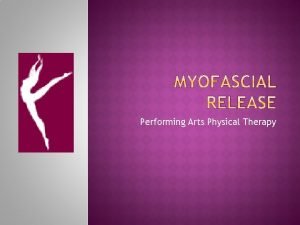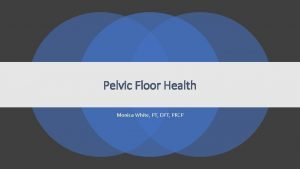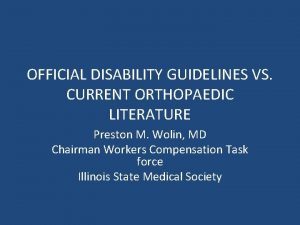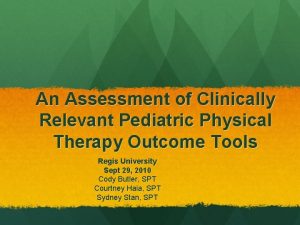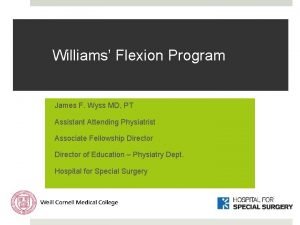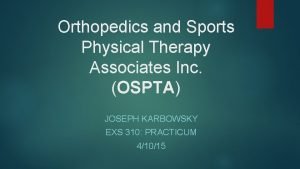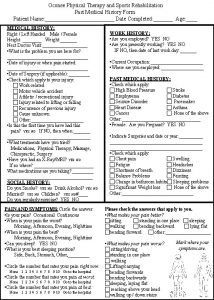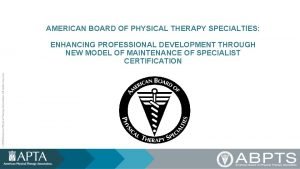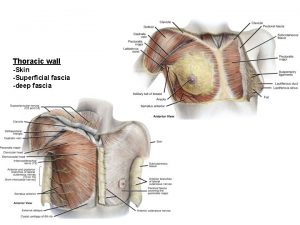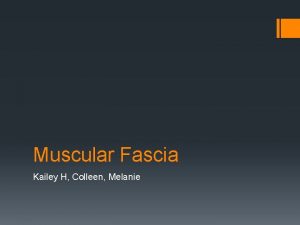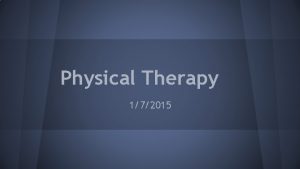Performing Arts Physical Therapy To explain what fascia
























- Slides: 24

Performing Arts Physical Therapy

To explain what fascia is. � To increase understanding of how fascia becomes tight. � To describe what occurs with a Myofascial Release (MFR). � To state the goal of MFR. � To point out candidates for MFR. � How physical therapist can evaluate for Myofascial restrictions. � To list the different types of release used by therapist. � To narrate how MFR is performed. � To find what current research is saying about MFR. � To call the need for future research. � To tell how patients will receive MFR at Performing Arts Physical Therapy (PAPT). �

� � � Fascia is specialized connective tissue (CT) that surrounds every muscle, nerve, bone, blood vessel, and organ at cellular levels. Fascia serves a a lubricant to allow motion and provides form and structure for the body. The functions of fascia include: � Supporting vessels and nerves � Allowing muscles to move over � Providing stability and contour one another as well as fluidity and lubrication � Participating in reflex loops from Paccinian corpuscles afferent fibers � Contracting and relaxing to respond to deformation � There are layers of fascia: � Superficial – thin elastic fibers under the surface of the skin � Deep – to separate muscles and organs for contour of the body The deepest layer is the Dura Mater which surrounds the brain.

� CT helps to define the body to ensure efficiency of motion. � CT is an adaptive tissue that responds to trauma to protect the body. � CT is made of: �Collagen provides support, strength, stabilization, and definition. �Elastin provides dynamic flexibility and absorbs tensile forces. �Ground Substance surrounds every cell to provide cushion and lubrication.

� Fascia tightens after trauma occurs to it. � Commonly during one single event or micro-traumas overtime. � The body’s reaction to trauma: � Collagen becomes dense and fibrosis. � Elastin loses its resiliency. � Ground substance solidities. � Fascial restrictions create abnormal strain patterns resulting in compression of joints and musculature producing pain and imbalances. � These restrictions can create up to 2, 000 pounds per a square inch of pressure on pain sensitive structures of the nervous system. Photo from Google images at www. skylorpainrelief. com.

� Back Pain � Chronic Fatigue � After Surgery � Jaw Pain ( TMJ) � Adhesions � Pelvic Floor Pain � Disc Problems � Neck Pain � Urinary Incontinence � Headaches � Scoliosis � Infertility Problems � Sports Injuries � Sciatica � Mastectomy Pain � Whiplash � Sprains � Urinary Urgency � Fibromyalgia � Hypermobility � Endometriosis � Neurological � Immobilization � Interstitial Cystitis � Dysfunction � Injections � Problematic Breast � Chronic Pain � Traumas � Implant/Reduction � Carpal Tunnel � Stressors � Menstrual Problems � Adhesions � Disease � Urinary Frequency � Lymphedema � Scars � Painful Intercourse � Strains � Vulvodynia � Coccydnia � Migraines � Inflammation � Episiotomy Scars

� Relieve fascial restrictions to normalize health and tension of the body. Images from Google images at www. eschmanpt. com, www. massageprocedures. com, & www. return 2 self. co. uk.

� MFR is a manual therapy technique where the fascia is mobilized to provide relief of restriction and pain for the patient. � The release takes can take 90 -120 seconds or until a reaction from the patient has occurred. � Reactions include: sighs, increased heart beat, decreased muscle tension, decreased pain, mechanical pressure on therapist, vasodilation, heat, overall relaxation or an emotional outburst. � The result is a softer, more pliable, and elongated tissue.

� � � Cranial-Cervical Junction Temporal (Jaw) fascial release Suboccipital release – Behind the head Hyoid System Thoracic Inlet Diaphragm � Top hand on inlet; bottom at C 7/T 1 � � � Radioulnar Release Carpal Tunnel Release – Wrist Thoracolumbar opening technique Abdominal Respiratory Diaphragm � Top hand base of rib cage; bottom T 12/L 1 Pelvic Diaphragm � � � � � Top hand at pubic bone; bottom at sacrum Anterior Iliosacral Joint Release Posterior Iliosacral Joint Release Sacral Plexus Release Patellar Release Tibiofibular release Extradural or nerve impingements Lumbosacral Decompression – Low back Muscle belly technique Scar tissue release

� Contraindications patients with: include but are not limited to � Malignancy � Aneurysm � Acute rheumatoid arthritis � Advanced diabetes � Severe osteoporosis � Healing fractures � Please also note that there may be an initial feeling of soreness after treatment as the body accommodates to this new balanced state after it was used to the unbalanced state prior.

1. Evaluate the patient. 2. Identify posture or range of motion imbalances. 3. Find the location of restriction. 4. Relieve biomechanical dysfunctions as well as trigger points if necessary. 5. Recheck imbalance. 6. Continue to treat with MFR. 7. Recheck imbalance. 8. Teach self-MFR techniques. 9. Strengthen and educate patient to ensure imbalance does not reoccur.

� Static posture �Leg length �Pelvic symmetry �Sacral positioning � Dynamic Posture �C/s Rom �B Shoulder Abd �Trunk Mobility �LE ROM �Hip ext �Knee Flx � Palpation �Superior – inferior glides �Medial – lateral glides �Clockwise –Counterclockwise glides �Joints: Compression distraction

� Proximal to distal � Most severe imbalance/restriction/asymmetry to less severe � Static before dynamic imbalance Image from Google image at www. equine-equilibrium. com.

� Based on evaluation of Myofascial dysfunction start with point of greatest restriction. � Apply pressure to area with hands. � One hand on top of the area of the body, the other underneath. � Both hands on the same surface in opposite directions. � Stack all three tested planes one at a time. � Pick one of each based on which direction of the two had the greatest ease of motion. � For all joints apply distraction or compression before stacking on planes. � For joints of the lower extremity only use one plane at a time. � Hold fulcrum there until tension dissipates.

� Place both hands side-by-side on the muscle belly. � For: �Quadriceps �Hamstrings � Grip belly. � Stack 3 planes. � Maintain fulcrum until release. �Gastrocnemius �Tibialis Anterior �Deltoid �Biceps �Brachioradialis

� Place pads of fingers of both hands along the length of the scar. �Use as many fingers will fit on the length of the scar. � Apply pressure. � Maintain pressure while moving in the 3 planes of ease. Image from Google image at www. facebook. com.

� Perform MFR after biomechanical dysfunctions have been treated with muscle energy or mobilizations. � Perform MFR after calming severe muscular spasms using techniques such as Strain Counter. Strain or Trigger Point Release. � Teach self-MFR techniques such as with pressure or foam rolling. � Strengthen and educate to ensure the dysfunction does not reoccur. Image from Google image at www. tumblr. com

� Decreased pain � Improved blood flow � Improved alignment � Improved joint function � Improved sleep � Improved quality of life � Decreased anxiety � Decreased fatigue � Decreased stiffness � Decreased muscle activity & vigor after stressful exercise or performance.

� MFR works to change the course of bodily functions to reset imbalances to progress in a balanced state. � Effects �Until of MFR can last motion causing trauma is repeated. �Research has found up to a 6 month post treatment. �Research also shows that benefits can be achieved with a physical therapy visit once a week. �Further lasting benefits are noted when self-MFR is performed.

� Intraoral MFR for chronic TMJ pain has found significant results in pain and opening when used with self-MFR treatments 1 year later.

� People with hypermobility syndromes have global dysfunction. � Global dysfunction = increased myofascial restriction. � It is important to find the most prevalent restriction to release. � Care after the MFR is performed must be done by strengthening to ensure that the dysfunction does not reoccur due to the hypermobility.

� Research states that patients with fibromyalgia had a significant reduction in pain after MFR. � MFR provides a consistent pain reduction for patients with fibromyalgia when compared to massage alone.

� Performing Arts Physical Therapy will aim to address your myofascial restriction to provide you with relief from your pain. We will help you return to the performance of your life the way you planned with some of our tips and tricks to keep it from reoccurring. � Any questions please direct them to: info@performingartspt. com. Image from Google images at www. featherstouchmassage. com.

1. 2. 3. 4. 5. 6. 7. 8. 9. 10. 11. 12. 13. Barnes MF. (1997). The basic science of myofascial release: morphologic change in connective tissue. J Body and Move Therap. 1; (4): 231 -238. Geeza, G. (2012). Myofascial Release Module: Lecture Notes. U of Scranton. Barnes JF. (1996). Performance Injuries - Fascia: The Body's Shock Absorber. PT Today. Hughes M. (2012). Myofascial Release (MFR): An overview. Hospital of Special Surgery. www. hss. org. Barnes JF. (2005). Scientific Rationale for MFR. Myofascial release treatment centers and seminars. Castro-Sánchez AM, Matarán-Peñarrocha GA, Granero-Molina J, Aguilera- Manrique G, Quesada-Rubio JM, & Moreno-Lorenzo C. (2010). "Benefits of Massage-Myofascial Release Therapy on Pain, Anxiety, Quality of Sleep, Depression, and Quality of Life in Patients with Fibromyalgia. " National Center for Biotechnology Information. U. S. National Library of Medicine, 28 Dec. 2010. Barnes JF. (2005). Scientific Rationale for MFR. Myofascial release treatment centers and seminars. Arroyo-Morales M, Olea N, Martinez MM, Hidalgo-Lozano A, Ruiz-Rodriguez C, & Diaz-Rodriguez L. (2008). Psychophysiological Effects of Massage-Myofascial Release after exercise: A randomized sham-control study. J Alt and Complem Med. 14; (10); 1223 -1229. Castori M. (2012). “Ehlers-Danlos Syndrome, Hypermobility Type: An Underdiagnosed Hereditary Connective Tissue Disorder with Mucocutaneous, Articular, and Systemic Manifestations, ” Dermat. Vol: 2012. Kalamir A, Bonello R, Graham P, Vitiello AL, & Pollard H. (2012). Intraoral Myofascial Therapy for Chronic Myogenous Temporomandibular Disorder: A Randomized Controlled Trial. J Manip and Physiol Thera. 35; (1): 26 -3. Healey KC, Hatfield DL, Blanpied P, Dorfman LR, & Riebe D. (2011). The Effects of Myofascial Release with Foam Rolling on Performance. J Stren and Cond Res. 25: S 30 A. Castori M, Morlino S, Celletti C, Celli M, Morrone A, Colombi M, Camerota F, Grammatico P. (2012). Management of pain and fatigue in the joint hypermobility syndrome (a. k. a. Ehlers–Danlos syndrome, hypermobility type): Principles and proposal for a multidisciplinary approach. Am J Med Genet. Part A; 158 A: 2055– 2070. Liptan G, Mist S, Wright C, Arzt A, & Jones KD. (2013). A pilot study of myofascial release therapy compared to Swedish massage in Fibromyalgia. J Body and Move Therap. 1360 -8592. Image on first slide from www. performingartspt. biz.
 Performing arts physical therapy
Performing arts physical therapy Ual level 3 performing and production arts
Ual level 3 performing and production arts Btec level 3 extended diploma in performing arts
Btec level 3 extended diploma in performing arts Learning foundation and performing arts
Learning foundation and performing arts Performing arts techniques
Performing arts techniques Health and safety in performing arts
Health and safety in performing arts Health and safety in performing arts
Health and safety in performing arts Btec tech award performing arts component 1
Btec tech award performing arts component 1 Zaha hadid abu dhabi performing arts centre
Zaha hadid abu dhabi performing arts centre What is upaf
What is upaf Pectoralis major
Pectoralis major Creative arts term 3
Creative arts term 3 Psychodynamic and humanistic therapies have in common
Psychodynamic and humanistic therapies have in common Bioness integrated therapy system price
Bioness integrated therapy system price Humanistic therapy aims to
Humanistic therapy aims to Monica white physical therapy
Monica white physical therapy What is odg guidelines
What is odg guidelines Physical therapy computer software
Physical therapy computer software Pediatric physical therapy outcome measures
Pediatric physical therapy outcome measures Williams flexion program
Williams flexion program Ospta belle vernon
Ospta belle vernon Oconee physical therapy
Oconee physical therapy Hops evaluation example
Hops evaluation example Mosc apta
Mosc apta Jmu physical therapy
Jmu physical therapy
